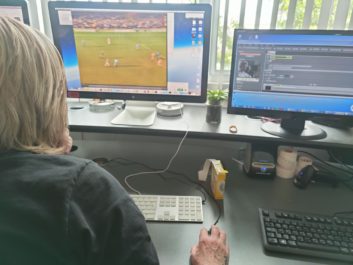 When COVID-19 lockdown restrictions started to hit home, the entire broadcast industry was concerned about the impact lockdown would have on both business and customers.
When COVID-19 lockdown restrictions started to hit home, the entire broadcast industry was concerned about the impact lockdown would have on both business and customers.
However, few could have predicted that the slowdown in live entertainment would lead to customers re-activating thousands of hours of archived content.
For Iron Mountain Entertainment Services (IMES) these events marked 2020 out as its busiest year to date.
Sports broadcasters were severely impacted as the tap of live events was cut off almost overnight. With great uncertainty as to when the season would resume and with rights holders and subscribers to satisfy the crisis focused renewed attention on the archive.
Iron Mountain Entertainment Services UK (IMES) worked on two major projects during this period, one to digitise assets for Premier League content produced by IMG for international broadcasters and one to do the same for the All England Lawn Tennis Club’s (AELTC) Wimbledon footage.
“In the time of COVID-19, archives have come back out of the basement to take centre stage, ensuring our customers could keep their sport alive and keep fans entertained in the days when there was a total ban on activity,” says Simon Jones, head of studio at Iron Mountain Entertainment Services UK. “Content owners are also now realising that their archive material represents a valuable potential revenue source, and the key to that monetisation is quickly connecting fans and advertisers to content that matters.”
The process
IMES were tasked by IMG with preserving the heritage of the original 12 seasons of the Premier League archive. This comprised of 380 matches per season which amounts to around 7,000 hours’ worth of content.
This process didn’t just serve an immediate aim to fill schedules. The content will be used for decades to come across all broadcasting that is authorised to use Premier League archive content.
The tapes – some 6,000 of them – were stored in archive crates and held on shelves, initially with Bonded Services/IMES, then with CCK Media.
When the tapes were with IMES they were stored under temperature-controlled conditions. When CCK Media took over the tape storage it was under ambient warehouse conditions. Both companies adhered to the standards of FACT with all necessary security and safety precautions.
Luckily, the tape formats of the day were fairly robust and the content typically comes in on either Beta SP or Digibeta. Nonetheless the tapes are aging and can be prone to issues causing drop out and errors. Occasionally, the oxide of the tape itself is shedding.
“Most of these issues can be fixed by cleaning, however, and we rarely run into something that can’t be sorted,” he says.
Prior to digitisation each tape was cleaned by Bonded/IMES’s RTI tape cleaner.
Each tape contained the original broadcast programme as a clean feed – that it without graphics. The metadata associated with each tape included team names, date of each match and a unique barcode. The IMES team created a table to track which matches had been completed as well as adding in any score data.
“We found a few interviews as well matches that had been incorrectly labelled by the operator but these were rare instances. Overall, the archive was very well catalogued.
The workflow sees the tapes carefully checked against their manifest to ensure they’re showing what they say they are before being ingested. Some of the AI-based tools often used to automate QC can generate a frustrating number of false positives, so both IMES’ clients and its own studio engineers prefer to steer clear of using them to QC.
“Automated QC tools are ‘dumb’ so they will flag what they think are issues with the audio or video on a tape, often these flags end up being incorrect so IMES prefers to use trained operators to look for any errors,” says Jones. “Using human operators to check the tapes delivers far more reliable results.”
The material was then delivered as IMX50.mxf files via Media Shuttle to IMG. The four audio channels per match were carried across as it was on the original source tapes.
“In order to continue to keep the tapes rolling during COVID-19, we needed to introduce safe working practices that inevitably added complexity to the workflow. We have a room that’s big enough for two operators but not more, so we moved the QC and evaluation stations outside into another area to ensure these crucial client projects could continue uninterrupted.”
The outcome
“This wasn’t a rush job,” Jones adds. “This was about careful attention to detail. The client should not have to go through this process again if we’re doing our job correctly. Batches were delivered as agreed and the project took around a year to complete.”
The Premier League archive job was so successful that IMG subsequently engaged with IMES on a new project.
Jones says, “We’ve just upgraded our systems to allow our clients to access their material in the cloud, and we’ve also fully implemented the IMES Media Asset Management platform solution, ensuring team collaboration from anywhere in the world to organise, access, and monetise media content. Digitisation is a 24/7 process nowadays and we need to be providing that 24/7 access in turn.”




